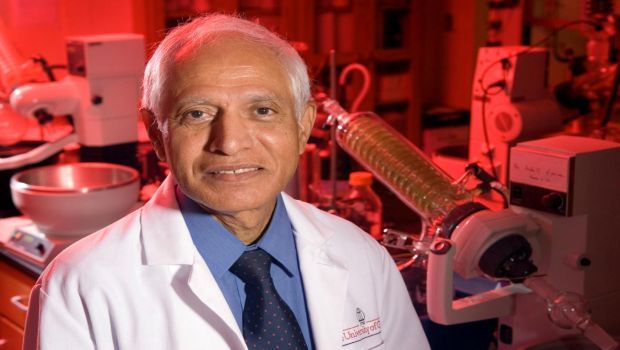UGA Researchers Discover Potential Treatment for Drug-Resistant Tuberculosis
Researchers at the University of Georgia have developed a new small molecule drug that may serve as a treatment against multidrug-resistant tuberculosis, a form of the disease that cannot be cured with conventional therapies. They describe their findings in a paper published recently in Bioorganic and Medicinal Chemistry Letters.


Led by Vasu Nair, researchers at the University of Georgia have developed a new small molecule drug that may serve as a treatment against multidrug-resistant tuberculosis. Photo courtesy of Paul Efland/University of Georgia.
Researchers at the University of Georgia have developed a new small molecule drug that may serve as a treatment against multidrug-resistant tuberculosis, a form of the disease that cannot be cured with conventional therapies. They describe their findings in a paper published recently in Bioorganic and Medicinal Chemistry Letters.
Nine million people contracted tuberculosis in 2013, and 1.5 million died from the disease, according to the World Health Organization. While standard anti-TB drugs can cure most people of Mycobacterium tuberculosis infection, improper use of antibiotics has led to new strains of the bacterium resistant to the two most powerful medications, isoniazid and rifampicin.
"Multi-drug resistant TB is spreading rapidly in many parts of the world," says Vasu Nair, Georgia Research Alliance Eminent Scholar in Drug Discovery in the UGA College of Pharmacy and lead author of the paper. "There is a tremendous need for new therapies, and we think our laboratory has developed a strong candidate that disrupts fundamental steps in the bacterium's reproduction process."
Just like other living organisms, the genetic information contained in M. tuberculosis undergoes a complex process known as transcription in which the bacterial enzyme, DNA-dependent RNA polymerase, or RNAP, produces TB RNA. This molecule is involved in processes that produce critical bacterial proteins that the organism needs to survive.
The compound Nair and his colleagues developed works by binding to magnesium and specific amino acids found within the bacterium, interrupting the production of RNA.
"The compound we developed strongly inhibits the growth of the bacterium and renders it incapable of reproducing and spreading infection," Nair says. "More importantly, the compound shows very low levels of cytotoxicity, which means that it is not harmful to the body."
The research team members also performed extensive studies to determine if their newly developed compound had an appropriately long half-life and could be cleared from the body through normal biochemical mechanisms.
"All our tests were very favorable," Nair says. "The half-life is a little over 14 hours, and all traces of the drug are expected to be cleared through normal bodily functions."
While Nair and his colleagues were pleased with their new compound, they were surprised to discover through preliminary experiments that it also exhibited strong anti-HIV properties, opening the door for dual therapeutic applications.
A dual-purpose drug would be a windfall for clinicians, because the risk for developing TB is between 26 and 31 times greater in people living with HIV than those without HIV infection, according to the WHO.
"This discovery of dual activity against both retroviruses and drug-resistant gram-positive bacteria is unique and opens a new chapter in drug discovery in this area," Nair says.
Innovation Gateway, UGA's technology licensing office, is seeking commercial partners to help develop this drug. A license would include humanitarian licensing terms to help ensure access to the drug by people in need at an affordable cost.
Source: University of Georgia
Outbreak Detection, Patient Protection: The Legal Upside of Genomics in Infection Prevention
May 21st 2025A string of infections following routine knee surgeries in Tennessee has escalated into litigation, raising questions about how—and when—health care facilities should detect outbreaks. As genomic surveillance gains traction in infection prevention, some fear it could increase legal risk. In reality, it may offer hospitals their strongest legal defense.
Silent Saboteurs: Managing Endotoxins for Sepsis-Free Sterilization
Invisible yet deadly, endotoxins evade traditional sterilization methods, posing significant risks during routine surgeries. Understanding and addressing their threat is critical for patient safety.